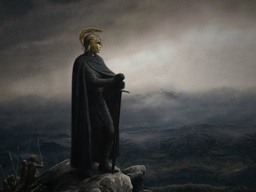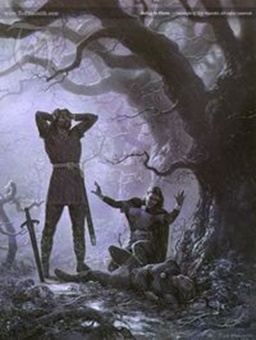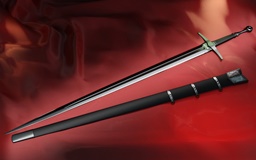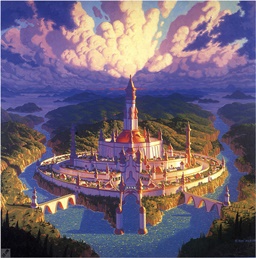Tolkien’s Magic Sword: Anglachel
 I wrote a post here at Black Gate about Nauglamir, the necklace of the dwarves. Personally, I would love to see that tale as a separate novella (note to self: I’ve written Doyle and Stout – do not take on Tolkien…).
I wrote a post here at Black Gate about Nauglamir, the necklace of the dwarves. Personally, I would love to see that tale as a separate novella (note to self: I’ve written Doyle and Stout – do not take on Tolkien…).
Today’s essay is about another item: a magic sword named Anglachel. It is really a minor element of the book, but the story of it weaves in and out of many other parts. That’s one of the true wonders of The Silmarillion. It’s a vibrant, interconnected history of Tolkien’s world. There are just SO many characters and stories throughout it.
I’m in that weird, small group which cites The Silmarillion as their favorite Middle Earth book. It is essentially a mythology and history of Tolkien’s world. While I love Robert E. Howard’s Hyboria, Tolkien set the fantasy standard for world building. The Silmarillion is really several long stories combined into one book.
John Ronald Ruel Tolkien, creator of Middle Earth, was a master storyteller. The Hobbit, with its tale of plucky hobbits and dwarves, a wizard, a magic ring and a dragon made what has been termed high fantasy appealing to a large audience. And The Lord of the Rings is an epic saga of good versus evil and of never giving up on what is right, no matter how daunting the odds.
Both The Hobbit and The Lord of the Rings included bits of Middle Earth history. Gimli sang ‘The Song of Durin’ as the fellowship travelled through Moria and Aragorn sang a song of Beren and Luthien early in his travels with the hobbits. It was the history of Middle Earth and events of the First Age that were always dear to Tolkien’s heart. He tried for decades to get The Silmarillion published and he constantly revised and added to his creation.
Of course, magic swords are one of the most popular tropes in fantasy (and role playing games). The appeal can probably trace its roots back to King Arthur’s legendary blade, Excalibur. Bilbo was given the elven dagger named Sting in The Hobbit. Aragorn’s Anduril (the reforged Narsil) is an important symbol in The Lord of the Rings, while Gandalf bore Glamdring (Hey Gary Gygax, who says wizards can’t use swords?), a sword that traced its lineage back to Turgon of Gondolin. As does its ‘mate,’ Orcrist, which found its way to Thorin as he sought to reclaim Erebor for Durin’s folk.
OF FORGING & DORIATH
Anglachel and Anguirel were twin swords, forged by an elf named Eol in the First Age from the iron of a meteorite. Eol was a Sindaran, or Gray Elf, and a kinsman of Thingol, lord of the kingdom of Doriath.
Doriath was protected from enemies by a magic spell known as ‘The Girdle of Melian,’ woven by the queen of Doriath. Eol was not happy living within the boundaries of the Girdle and he gave Anglachel to Thingol in exchange for permission to dwell in the forest of Nan Elmoth, which was outside of Melian’s protection. He avoided other elves, living in the darkened woods and consorting with dwarves (something just not done by the elder race). I’ll tell Eol’s story in a future post, but we’re about done with him for now.
Melian urged Thingol not to wield the sword, warning that the blade was full of malice: presumably inheriting some of its crafter’s character. Heeding her words, Thingol kept it in the armory at Menegroth.
There it lay for some eighty years until Thingol’s foster son, the human Turin Turambar (the focal character in The Children of Hurin), killed one of Thingol’s advisors and fled, becoming an outlaw. Beleg Cuthalion (Strongbow), greatest of the March Wardens, went in search of his friend. Beleg, given choice of Thingol’s weapons, took Anglachel to pair with his marvelous bow, Belthronding. Melian warned him of the sword’s nature, but Beleg was unmoved, to his detriment.
WITH TURIN TURUMBAR
 Much happens and eventually Beleg finds Turin, who has been captured by orcs. The elf is rescuing Turin when the latter awakes and, thinking that Beleg is an orc come to torture him, wrests away Anglachel and slays him with it. This tragedy can be attributed to Morgoth’s curse of doom upon Hurin’s family, rather than to any shadow hanging over the sword. Now, if it were the latter, that would have to be one heck of a shadow, as Turin is arguably the most tragic character in the history of Middle Earth. If you decide to read The Children of Hurin, or “Narn I hin Hurin,” from Unfinished Tales, have a box of tissues handy.
Much happens and eventually Beleg finds Turin, who has been captured by orcs. The elf is rescuing Turin when the latter awakes and, thinking that Beleg is an orc come to torture him, wrests away Anglachel and slays him with it. This tragedy can be attributed to Morgoth’s curse of doom upon Hurin’s family, rather than to any shadow hanging over the sword. Now, if it were the latter, that would have to be one heck of a shadow, as Turin is arguably the most tragic character in the history of Middle Earth. If you decide to read The Children of Hurin, or “Narn I hin Hurin,” from Unfinished Tales, have a box of tissues handy.
Turin claimed Anglachel, though it went black and dull after Beleg’s death. He took it to the smiths of Nargothrond and it was reforged as Gurthang, which means ‘iron of death.’ Turin became a fearsome orc slayer and was known throughout Beleriand as Mormegil (the ‘Black Sword’). He even used the sword to slay Glaurung, the first and greatest of Morgoth’s dragons.
However, at death’s door, Gluarung revealed to Turin’s wife, Niniel, that she was actually his sister, Neinor. Horrified, she threw herself into a river and presumably drowned. When Turin realized that Niniel truly was Nienor, he fell upon Gurthang, killing himself. The sword broke and the shards were laid to rest with him.
ANGLACHEL WAS ALIVE
While magic swords are common in the modern fantasy/RPG world, they were rare and prized in Middle Earth. Anglachel could cut through iron and it glowed with a pale fire, which truly marked it as a wondrous blade. It was also sentient, though that is not revealed until the end of its tale. Horrified to discover that Niniel was really his sister, Turin addressed the sword:
“Hail Gurthang! No lord or loyalty dost thou know, save the hand that wieldeth thee. From no blood wilt thou shrink. Wilt thou therefore take Túrin Turambar, wilt thou slay me swiftly?’ “
And from the blade rang a cold voice in answer:
“Yea, I will drink thy blood gladly, that so I may forget the blood of Beleg my master, and the blood of Brandir slain unjustly. I will slay thee swiftly.”
By mentioning Brandir’s unearned death and speaking of loyalty to Beleg, Gurthang’s words indicate that it wasn’t animated by the essence of Eol. The sword wants to allow Turin to right his wrongs by letting him kill himself. This is quite different from the dark malevolence of Elric’s Stormbringer, which delights in stealing the souls of the albino prince’s friends. Stormbringer is revealed to be a demon, and it speaks to Elric at the end of the epic saga, “I was a thousand times more evil than thou!”
However, if we dismiss Eol’s dark character as the source of Anglachel’s intelligence, there is no other indication of where the sword drew it’s abilities from. We could infer it was a combination of Eol’s craftsmanship and the meteorite iron, but that’s just pure guesswork.
SWORD OF DESTINY
 Tolkien’s publisher returned (and rejected) “The Quenta Silmarillion” (QS) in 1937. He stopped substantive work on it about that time and began writing what became The Lord of the Rings. The very end of the “QS” consists of the prophecy of Mandos, which tells of the end of days and what Christians will recognize as the establishment of the New Kingdom (Tolkien was Catholic).
Tolkien’s publisher returned (and rejected) “The Quenta Silmarillion” (QS) in 1937. He stopped substantive work on it about that time and began writing what became The Lord of the Rings. The very end of the “QS” consists of the prophecy of Mandos, which tells of the end of days and what Christians will recognize as the establishment of the New Kingdom (Tolkien was Catholic).
It foretells that Tulkas will battle Morgoth and on his left hand will be Turin, returned from the Halls of Mandos, “and the black sword of Turin shall deal unto Morgoth his death and final end; and so shall the Children of Hurin and all men be avenged.”
So, in being the instrument to slay Morgoth, Anglachel has a greater role as an artifact than even the One Ring! For Morgoth/Melklor is the true enemy: Sauron was just his lieutenant.
ANGUIREL
Eol’s son, Maeglin, stole Anguirel: most likely when the boy and his mother, Aredhel, fled to Gondolin. He had his father’s darkness inside and he betrayed the location of the hidden city of Gondolin to Morgoth. Magelin battled Tuor during the sack of the city and lost, after which he was thrown down the mountain to his death. Presumably he wielded Anguirel during the fight and it is not known what became of the sword.
Was Anguirel ‘alive,’ like Gurthang? There is no indication of it, but Anguirel was twin to Gurthang’s original form, Anglachel. Was Anglachel sentient, or is that something that came to be after it was reforged as Gurthang? If the latter, then Anguirel likely did not share its twin’s power.
MISCELLANEA
As with the story of the Nauglamir, the story evolved and changed in the composition and elements are not the same throughout. “The Lay of the Children of Hurin” was a poem of over two thousand lines, but Tolkien abandoned it to begin working on another log poem, this one about Beren and Luthien (which he also left uncompleted). Beleg’s sword is mentioned, but Anglachel is not part of the Legendarium yet. Turin’s story then evolved in narrative form and Anglachel became a part of it.
Turin’s story is inextricably linked with Doriath and Menegroth and also with Nargothrond. As Hurin’s child, one could also add the disastrous Battle of Unnumbered Tears (Nirnaeth Arnoediad) and the Fall of Gondolin. Or, following another branch, Anglachel leads to Eol, Maeglin and yet again, the Fall of Gondolin. Heck, let’s toss in some Turgon, Earendil and lots more. The Silmarillion is a collection of entwined stories. I’ll be commenting on more tales, but here are some basics related to this post:
ENCYLOPEDIA
 GONDOLIN – Secret elven city founded by Turgon. The sack of Gondolin was one of Morgoth’s long-desired goals in the First Age.
GONDOLIN – Secret elven city founded by Turgon. The sack of Gondolin was one of Morgoth’s long-desired goals in the First Age.
EREBOR – The Lonely Mountain. After the loss of Moria (Khazad Dum), some dwarves (Durin’s Folk) founded The Kingdom Under the mountain in Erebor. That, of course, attracted Smaug the Dragon and led to The Hobbit.
THINGOL – A Sindaran Elf and one of the most prominent of the Eldar (elves) in Middle Earth History. He married Melian and ruled Doriath for almost 4,000 years. He figured prominently in the stories of Beren and Luthien (his daughter), the Silmarilli, Turin and the Nauglamir.
MELIAN – Wife of Thingol, she was a Maia. Maia were spirits who descended to Arda (the world) to help shape it. The Maia were of the Ainur, divine spirits created by Iluvatar (the Creator). She was mother to Luthien and tutor to Galadriel. By marrying Thingol and having Luthien, she brought the Ainur bloodline into the world. Elrond and Elros were her descendants.
MENEGROTH – The Halls of Thingol, built by the dwarves of Nogrod and Belegost. Menegroth means, ‘The Thousand Caves.’ Morgoth never conquered it, but it was sacked first by dwarves and later by the sons of Feanor (those Feanor kids sure needed some discipline when they were growing up!).
BELEG – After Turin, Beleg Strongbow is the most prominent character in the story of Anglachel. The elf was the finest archer and huntsman of his age. Thingol refused to fight alongside Feanor’s sons because of the First Kinslaying. So, only Beleg and fellow captain Mablung fought in Nirnaeth Arnoediad, The Battle of Unnumbered Tears. Morgoth overran all of Beleriand except for Doriath, where the two elves returned afterwards.
NIRNAETH ARNOEDIAD – The disastrous fifth battle of the Wars of Beleriand. Men switched to Morgoth’s side during the fight and the elves, dwarves and remaining men were routed. Except for Doriath, all of Beleriand was conquered, with much of it being razed by orcs. The location of Gondolin did remain hidden, which was a small victory.
TURIN – Son of Hurin, he lived his life under Morgoth’s curse on Hurin and his family. Greatest warrior of men, his doom followed him to his death.
GLAURUNG – The first of Morgoth’s dragons, he was land-bound. Glaurung was first seen during the Battle of Unnumbered Tears, where he was seriously wounded by the dwarf king, Azaghel (whom he slew). The dragon withdrew and missed the remainder of the battle. Years later, Glaurung led an army of orcs in sacking the elven fortress city of Nargothrond. The dragon enscorcelled both Turin and his sister, Nienor, carrying out the doom of Morgoth. He was slain by Turin, wielding Anglachel, but his dying words led to the deaths of both Neinor and her brother.
BRANDIR – Brandir the Lame was the leader of the men of Brethil. When he told Turin that Nienor/Neinel was really his sister and she was dead, an enraged Turin insulted him and then slew him with Gurthang.
MANDOS – An Ainur and one of the Valar (powerful creations of Iluvatar; they are his messengers. They were not worshipped, but in effect they were gods), Mandos was the judge of the dead and pronounced judgement in matters of fate. The spirits of elves and men went to his Halls to wait for their fates to be determined. Thorin made a reference to going to the Halls, though there is no other evidence of dwarves joining elves and men there.
MORGOTH – Also named Melkor, he was the greatest of the Ainur and the Great Evil. He is the source of most of the woe in the First Age (though Feanor and his sons certainly did their share). He was defeated by the ‘good’ Ainur twice – the second time “for good,” marking the end of The First Age. Suaron was his lieutenant and became the great foe for The Second and Third Ages.
Bob Byrne’s ‘The Public Life of Sherlock Holmes’ column ran every Monday morning at Black Gate from March 2014 through March 2017 (still making an occasional return appearance!). He also organized Black Gate’s award-nominated ‘Discovering Robert E. Howard’ series.
He is a member of the Praed Street Irregulars, founded www.SolarPons.com (the only website dedicated to the ‘Sherlock Holmes of Praed Street’) and blogs about Holmes and other mystery matters at Almost Holmes.
He has contributed stories to The MX Book of New Sherlock Holmes Stories – Parts III, IV, V and VI.
Bob seems to be torn between writing about fantasy, gaming or the mystery genre.
I love this summary!
One small but significant correction: Tolkien was instrumental in Lewis’ conversion, not the other way around.
Great Post!
“Yea, I will drink thy blood gladly, that so I may forget the blood of Beleg my master, and the blood of Brandir slain unjustly. I will slay thee swiftly.”
The words of Gurthang are a big reason why I think Tolkien was such a great writer & storyteller. Consider what he does when he gives the black sword a voice:
1. Gurthang is Self-Aware – “I” is used three times in two sentences. Gurthang knows what and where it is, and who Turin is.
2. Gurthang has Free Will – “I will drink”, “I will slay”. No whining, none of this “I am just a tool in your hand” nonsense; it’s more like ‘yeah, I’ll kill you!”
3. Gurthang has a Memory. “…so I may forget the blood…” You don’t need to forget something if you have no memory to start with.
4. Gurthang knows what Justice is, and by extension, Right from Wrong. It knows that Brandir was unjustly slain; it was not right to slay an unarmed cripple whose only crime was to tell Turin a truth he did not want to hear.
5. Gurthang knows what Loyalty is. He calls Beleg “master”. Remember that Tolkien wrote from the viewpoint of the British tradition, where master refers to the concept of “Man & Master”, not “Master & Slave”. “Man & Master references a very personal loyalty that is almost feudal in nature. But why Beleg, when Eol actually made the sword and Thingol was the lawful owner? I think it is because Beleg Cuthalion is one of the most wholly admirable characters in the entire book. Between the time Thingol gives the blade to Beleg and his death, Anglachel is the sword of a hero, the Champion who protected Menegeroth, opposed tyranny and struck terror in the hearts of the forces of evil with a gleaming blade that could not be stopped. Then Turin killed Beleg by accident, and the sword turned black and dull.
Professor Tolkien not only breathed life into the magical sword Anglachel, he gave it Self-Awareness, Free Will, a Memory, a sense of Right & Wrong, and Loyalty. And he did it in two sentences and a total of thirty words.
I’ll never be able to write like that.
I think I enjoy the Silmarillion more than Lord of the Rings. But I had the books ruined by seeing the movies first. The Silmarillion was all new material to me. It just felt so epic and the feeling of loss is so strong.
Fingolfin fighting Morgoth is one of my favorite scenes in any work of fiction.
jmichaelmatkin – Thanks! I fixed the error. Can’t believe I got the Christian part of the post wrong.
John – Thank you. That was a pretty cool observation and I think it would be a neat blog post. Have you ever elaborated on those characteristics of the sword?
Glenn – Fingolfin is my favorite character in the book. I’ve wondered what became of Ringil after Morgoth slew him. I don’t think there is any account of the sword after Fingolfin fell.
I’ll add that Gil Galad and Aiglos are also favorites. I hate Feanor…
“Anglachel and Anguirel were twin swords, forged by an elf named Eol in the First Age from the iron of a meteorite.”
How often has this trope been used? I assume there is a rich history, although I only just discovered it with L. Sprague de Camp’s The Tritonian Ring.
Tuesday – Never thought of that. Stormbringer and Mournblade are the only ones that come to mind for me.
Glenn – the fight between Fingolfin and Morgoth is epic! There are so many great characters in this book, I can’t choose a favorite, but Fingolfin would certainly be in the running.
Mr. Byrne – I hate Feanor too. What a jackwagon.
I wish there was more about Gil-Galad and Aiglos.
Thank you, I haven’t yet written up everything I have to say about Anglachel, but I plan on doing so when I get my website up and running again.
[…] magic swords from The Silmarillion. If you’re not familiar with the history of Anglachel, you need to click on over and check it […]